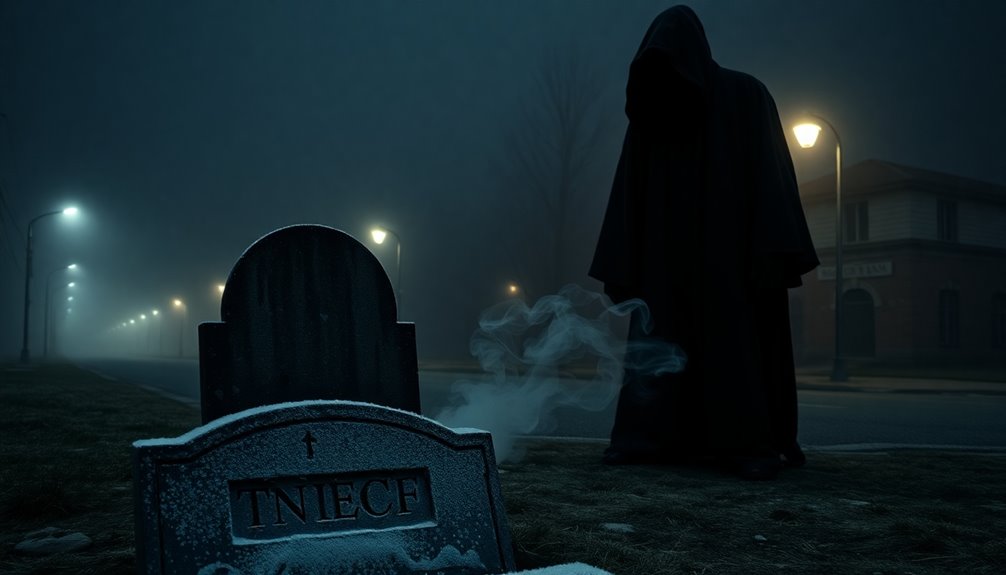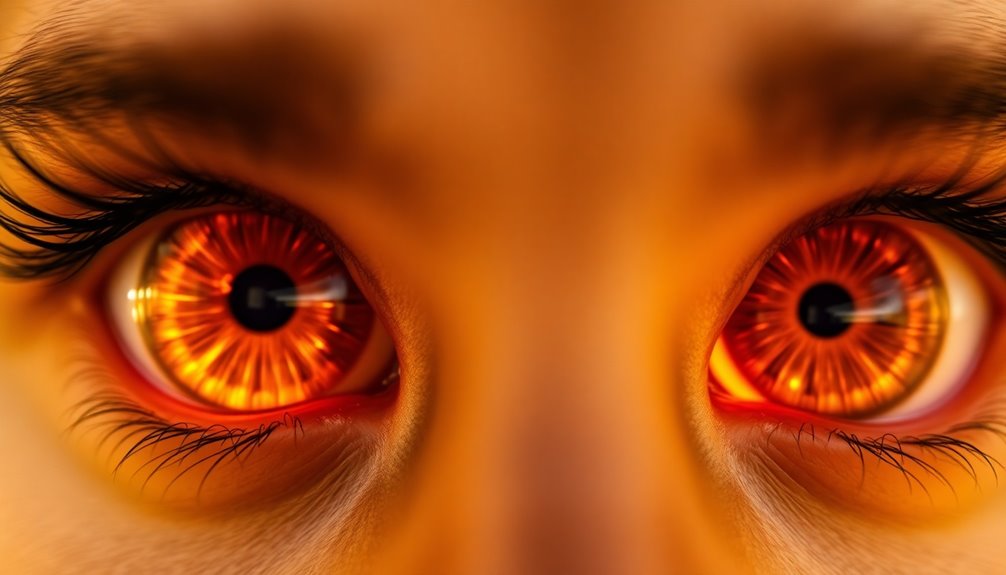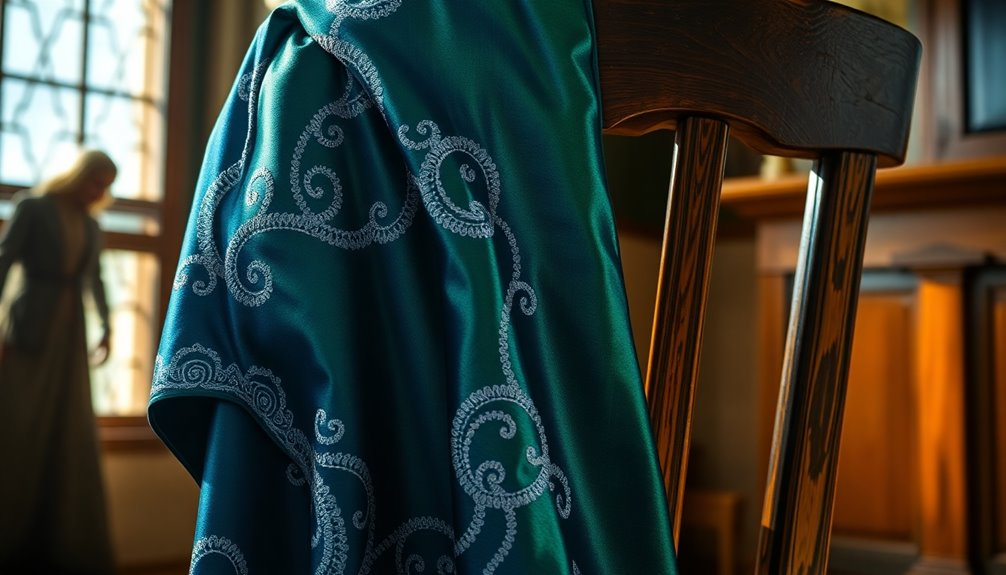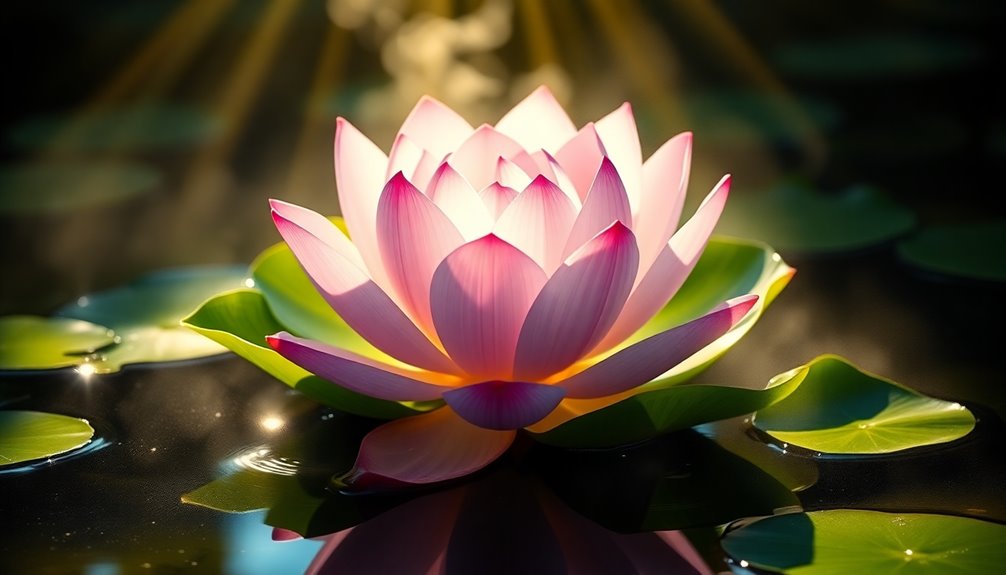In Romeo and Juliet, symbolism adds depth to the characters' emotions and experiences, making the story so much more exciting! Light and darkness represent love's purity and the danger of family feuds, showing how these opposites create conflict. Poison symbolizes the intense feelings that lead to tragic choices, illustrating love and loss. Other symbols, like flowers, reflect the beauty and fragility of their love. Gold and silver highlight true values versus materialism. By using these symbols, Shakespeare enriches the narrative, allowing you to experience the characters' struggles on different levels. Keep exploring, and you'll uncover even more fascinating insights!
Key Takeaways
- Light and darkness symbolize the contrast between love and conflict, emphasizing innocence and the dangers of family feuds in the narrative.
- Poison represents the tragic consequences of powerful emotions, illustrating how love can lead to both healing and destruction.
- Youthful passion and familial loyalty conflicts highlight the impulsiveness of young love and the dangers of loyalty to one's family.
- Themes of violence and feud underscore the destructive nature of hatred, showcasing how it tears apart relationships and leads to tragic outcomes.
- The significance of silver and gold illustrates contrasting values, with gold symbolizing materialism and silver representing true love and beauty in relationships.
Light and Darkness Symbolism

Exploring the symbolism of light and darkness in "Romeo and Juliet," you'll find that light often represents innocence, purity, and love. When Romeo talks about Juliet, he sees her as a shining light in his life. This love blossoms beautifully in the daylight, giving hope and joy to their story.
However, the contrast between light and darkness is essential too. While daytime scenes show their love, nighttime brings danger and violence. It's during these dark moments that the feud between their families threatens to overshadow their happiness.
Juliet's love is like a flower growing in the sunlight, full of life and promise. But the dark forces of their families and society loom over them, casting shadows on their dreams. This interplay of light and darkness not only highlights their love but also underscores the tragedy that comes when worlds collide.
Prince Escalus's speech after their deaths reminds us of the loss of innocence and the heavy consequences of their families' feud. Through this symbolism, Shakespeare paints a vivid picture of love and tragedy, helping you feel the characters' emotions deeply.
The dance of light and darkness makes their story even more powerful and unforgettable!
The Role of Poison

In "Romeo and Juliet," poison plays a huge role in showing both love and desperation.
It symbolizes how powerful feelings can lead to tough choices, like when Romeo buys poison to escape his heartbreak.
This highlights the tragic consequences that come from their decisions, reminding us how love can sometimes take unexpected turns.
Dual Nature of Poison
Amidst the tragic unfolding of "Romeo and Juliet," poison emerges as a powerful symbol that embodies love's dual nature—both a means of escape and a harbinger of destruction.
Poison symbolizes the intense emotions that drive Romeo and Juliet to make desperate choices. When Romeo gets the poison from the apothecary, it shows how deeply he loves Juliet. He'd rather choose death than live without her. This shows just how far love can push a person.
Juliet's use of the sleeping potion reflects good intentions that lead to unintended consequences. She hopes to escape her situation, but instead, it triggers a heartbreaking series of misunderstandings. The moment she seeks poison from Romeo's lips is a beautiful yet tragic metaphor for her commitment to him. It highlights their deep connection, but also the danger that love can bring.
Moreover, poison represents the hatred and rivalry between the Montagues and Capulets. Their feud creates a world filled with chaos and pain.
In this way, poison isn't just a physical substance; it's a powerful symbol of love's potential for both joy and sorrow.
Symbol of Desperation
Throughout "Romeo and Juliet," poison serves as a stark symbol of desperation, illustrating how love can drive individuals to extreme measures. You see this when Romeo, unable to live without Juliet, chooses poison to end his life. This tragic choice shows just how deep his love goes.
The poison he gets from the apothecary reflects the dark side of their families' feud, showing how love can turn deadly.
Juliet's use of the sleeping potion adds to this theme. She takes it to escape her troubles, but it leads to misunderstandings and her heartbreaking fate. The imagery of poison throughout the play highlights the connection between love and death, reminding us that something meant to help can cause terrible results.
Here are a few key points about the symbol of desperation in the play:
- Poison represents extreme love and despair.
- Romeo's choice shows his commitment to Juliet.
- The feud corrupts love, leading to tragic choices.
- Juliet's sleeping potion complicates their story.
- The imagery emphasizes love's dual nature.
In the end, poison illustrates how love can push people to make fatal decisions, all in the name of passion.
Consequences of Choices
Poison not only symbolizes desperation but also underscores the tragic consequences of impulsive choices made in the heat of emotion. In "Romeo and Juliet," the decisions made by both Romeo and Juliet lead to heartbreaking endings. When Romeo chooses poison over life without Juliet, it shows his deep love and despair. Unfortunately, this choice results in irreversible tragedy.
Here's a simple table to illustrate the choices and their consequences:
| Character | Choice | Consequence |
|---|---|---|
| Romeo | Takes poison | Dies beside Juliet |
| Juliet | Uses a sleeping potion | Causes misunderstandings and death |
| Both | Love each other | Leads to tragic endings |
| Verona | Trades poison for gain | Reflects moral corruption |
| Choices | Driven by emotion | Result in irreversible outcomes |
The duality of poison is striking. The sleeping potion can heal, while the lethal poison destroys. This shows how love can lead to both hope and despair. Ultimately, the deaths of Romeo and Juliet remind us that choices made in intense moments can change everything forever. Their story teaches us to think before we act!
Significance of Silver and Gold
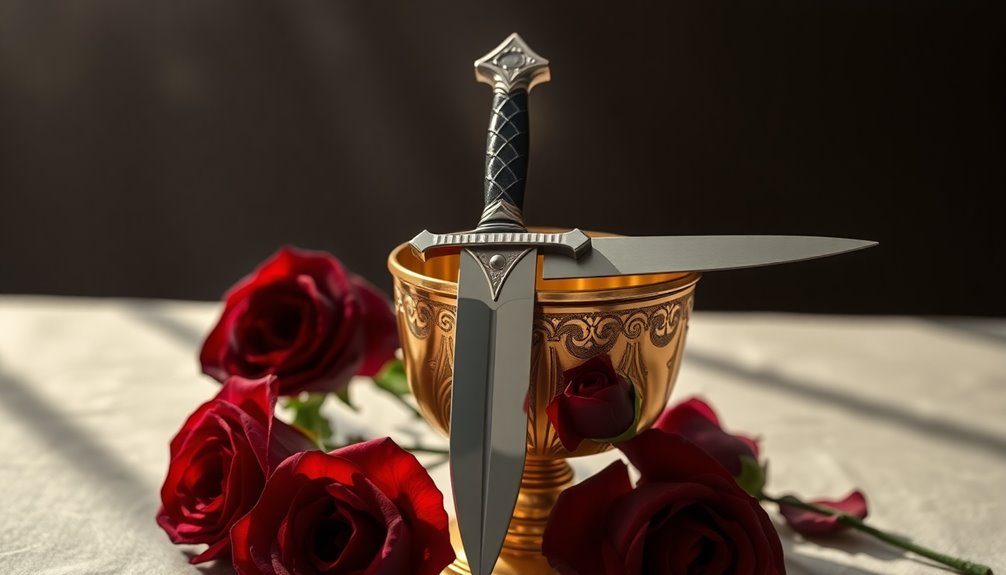
While the themes of love and conflict dominate "Romeo and Juliet," the contrasting symbols of silver and gold reveal deeper layers of meaning within the narrative. Gold represents materialism and greed, which fuel the ongoing feud between the Capulets and Montagues. This rivalry becomes destructive. When Romeo says gold is "more poisonous" than poison, he shows his disdain for wealth and how it can corrupt relationships.
On the other hand, silver stands for love and beauty. It enhances the romantic connection between Romeo and Juliet, symbolizing purity and emotional ties. Together, these symbols deepen your understanding of the characters and their motivations.
Here are some key points about silver and gold in the play:
- Gold highlights the destructive nature of greed.
- Romeo's remarks express his dislike for wealth.
- The families' plans for golden statues show their materialistic values.
- Silver symbolizes the beauty of love between the main characters.
- The contrast helps you see the societal pressures that shape their actions.
Ultimately, silver and gold add richness to the story, making you think about what truly matters in life: love or material wealth.
Floral Symbolism and Tragedy

Exploring floral symbolism in "Romeo and Juliet" reveals the delicate balance between beauty and tragedy in the characters' love story. You'll notice how Juliet's love is often compared to a budding flower. This suggests her love has great potential for growth and innocence.
In contrast, Romeo is likened to a rose. This symbolizes not only his beauty but also the pain that often comes with such allure.
Then there's Paris, who appears as an ordinary flower. This choice emphasizes his lack of the unique qualities that make Romeo the true object of Juliet's affection.
As the story unfolds, you see a powerful change when Juliet's bridal flowers transform into funeral flowers. This poignant moment symbolizes the tragic outcome of their love, marking the heartbreaking shift from hope to despair.
The recurring floral symbolism throughout the play beautifully illustrates how love and tragedy are intertwined. It reminds you that even the most beautiful things can quickly turn to sorrow.
Character Relationships and Symbolism
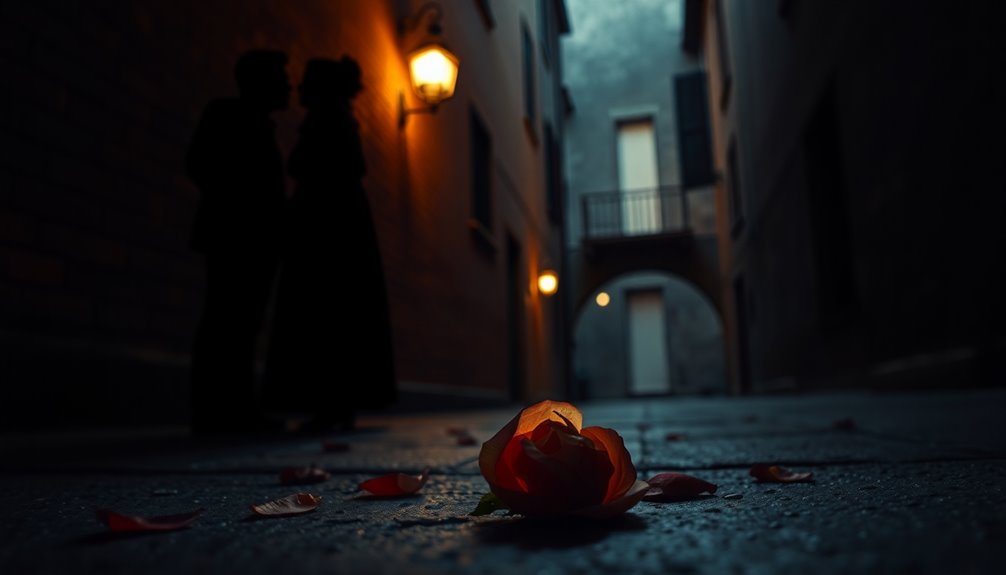
How do the character relationships in "Romeo and Juliet" deepen the play's symbolism? When you look closely, you'll see that each relationship adds layers of meaning to the story. For example, Romeo and Juliet's love represents youthful passion. Their bond is pure and intense, showing how deeply they feel, even when faced with family expectations.
Here are some key relationships that symbolize important themes:
- Juliet is the sun: Her brightness and warmth illuminate Romeo's life, signifying hope and love.
- Juliet's age: At just 13, she embodies both innocence and impulsiveness, highlighting the intensity of young love.
- Romeo's change: His shift from Rosaline to Juliet shows his growth from shallow infatuation to true love.
- The Nurse: She acts as a bridge between Juliet and her family, showing the complicated nature of support and loyalty.
- Mercutio and Tybalt: Their conflict symbolizes how outside forces from the family feud can destroy personal bonds.
These relationships help you understand the deeper meanings behind the characters' actions and feelings, making the play even more compelling!
Themes of Violence and Feud

In "Romeo and Juliet," the themes of violence and feud really stand out!
You see how the cycle of revenge pulls characters into conflicts, making them act out of loyalty to their families.
This leads to some sad consequences, showing us just how hatred can tear people apart, even when they care for each other.
Cycle of Revenge
The relentless cycle of revenge in "Romeo and Juliet" vividly illustrates how deeply entrenched feuds can spiral into senseless violence. The bitter rivalry between the Montagues and Capulets drives the characters to act irrationally, leading to tragic outcomes. You see this when Mercutio's death pushes Romeo into a vengeful quest against Tybalt.
Here are some key moments that highlight this cycle of revenge:
- The thumb-biting incident shows how trivial the feud's origins are.
- Tybalt's aggression fuels the toxic masculinity within the family feud.
- Romeo's transformation from a lover to a vengeful figure reveals the feud's destructive power.
- The Prince's decree points out the futility of their rivalry.
- Each act of violence leads to more pain and loss for both families.
As the story unfolds, you realize the cycle of revenge only brings destruction to both the Montagues and Capulets. The characters become trapped in a loop of retaliation, showing us how love and loyalty can quickly turn into hatred.
It's a powerful lesson on the dangers of holding onto grudges.
Familial Loyalty Conflicts
Caught in the crossfire of loyalty and violence, the characters in "Romeo and Juliet" illustrate the destructive impact of familial allegiance. The fierce feud between the Capulets and Montagues shows how loyalty to family can lead to misunderstandings and tragic consequences.
When Mercutio dies at Tybalt's hands, Romeo's desire for revenge takes over. This moment highlights how strong familial loyalty can push people to act without thinking, resulting in more violence.
Tybalt embodies the toxic masculinity that fuels the feud, showing how loyalty can harm personal relationships. The Prince tries to stop the fighting, revealing the futility of the families' rivalry. His decree reminds everyone that this loyalty creates a cycle of violence that hurts the whole community.
Even the playful thumb-biting incident at the play's start symbolizes how the feud's origins are often absurd. It emphasizes that trivial conflicts can escalate because of familial loyalty.
In "Romeo and Juliet," these themes remind us that loyalty, while important, can also lead to destruction if we let it control our actions. The story encourages you to think about how loyalty impacts your own life and relationships.
Consequences of Hatred
Hatred permeates every corner of "Romeo and Juliet," driving characters to make choices that lead to irreversible consequences. The violent feud between the Capulets and Montagues forms the heart of this tragedy. It's a powerful reminder of how destructive hatred can be.
Think about these key points:
- Mercutio's death sparks Romeo's desire for revenge.
- Tybalt's aggression shows how pride can lead to violence.
- The Prince tries to stop the fighting, but the hatred only escalates.
- The thumb-biting incident highlights how silly the feud is.
- Even bridal flowers, meant for love, become tainted by this conflict.
Each act of violence leads to more heartbreak, proving that hatred only brings sorrow.
Romeo and Juliet's love could've blossomed like beautiful bridal flowers, but instead, it's overshadowed by the feud's dark consequences. Their tragic end teaches us that holding onto hate can destroy lives and dreams.
As you explore these themes, remember how important it's to choose love over conflict. Only then can we hope for a brighter, more peaceful future.
Fate and Free Will

While the themes of fate and free will intertwine throughout "Romeo and Juliet," they create a complex narrative that explores human agency against a backdrop of predetermined destiny. From the very beginning, you're introduced to the idea of "star-crossed lovers." This phrase hints that Romeo and Juliet's love is doomed, controlled by the stars.
You see how characters, including Juliet, struggle against fate. For instance, she's a frightening vision of her own death, reminding us that sometimes, fate feels too powerful to change.
But wait! Characters also make choices. Romeo's impulsive decisions, like marrying Juliet or seeking poison, illustrate that free will plays a role too. These choices lead to tragic outcomes, making you wonder: can they change their fate?
The Friar's attempts to control their destiny with potions show that even with effort, fate can still rule their lives.
Time is another big player in this story. The urgency of their love and the timing of events highlight how fate and free will dance together. You can feel the excitement and tension as you read, knowing that every moment is vital in their doomed romance.
Literary Devices in the Play
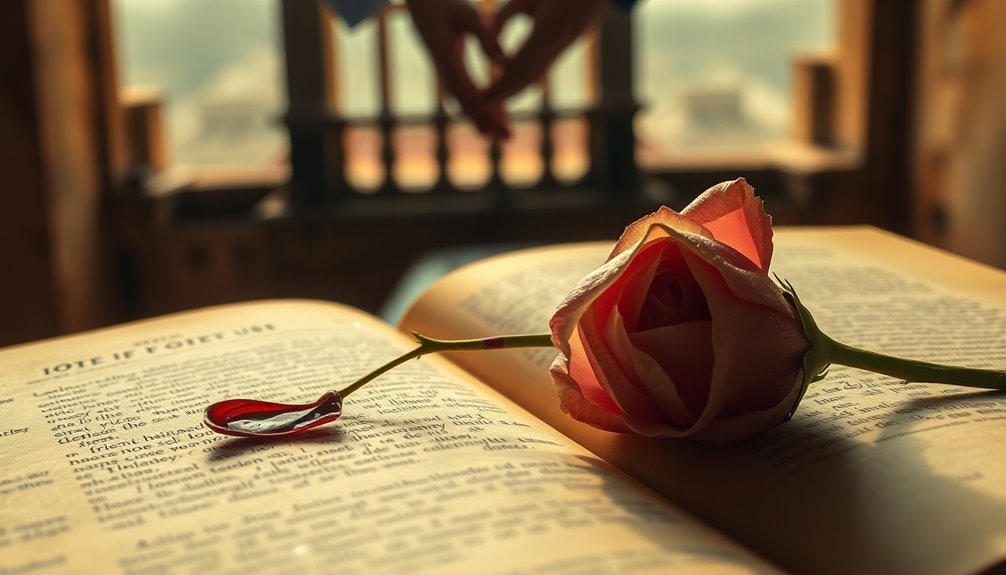
Numerous literary devices enhance the emotional depth and thematic complexity of "Romeo and Juliet." Symbolism plays a crucial role, with light and darkness representing the opposing forces of love and conflict. Juliet is often described as a shining light amidst the dark feud, showing how love can illuminate even the darkest situations.
Here are some key literary devices you'll find in the play:
- Floral Imagery: Juliet is compared to a blooming flower, highlighting the beauty and fragility of love.
- Poison Symbolism: The poison Romeo acquires represents the destructive power of their love and the tragic consequences of quick decisions.
- Foreshadowing: Early hints of tragedy, like Juliet's premonition of death, prepare you for the play's inevitable outcome.
- Celestial Imagery: Stars symbolize fate, emphasizing that their love was meant to be, but also meant for tragedy.
- Light and Darkness: This contrast highlights the tension between love and conflict, making the story more intense.
These devices not only enrich the narrative but also draw you closer to Juliet and Romeo's passionate journey. Enjoy exploring these themes!
Frequently Asked Questions
What Does Day Symbolize in Romeo and Juliet?
In "Romeo and Juliet," day symbolizes innocence, hope, and joy. You can see this when Romeo and Juliet meet in the bright sunlight, representing their pure love.
Daylight highlights their happiness and warm feelings for each other. When Romeo calls Juliet the sun, it shows how she brightens his life!
However, the contrast with night reminds you of the dangers they face, making their love even more precious and special.
What Is an Example of Symbolism in Shakespeare?
When it comes to symbolism in Shakespeare, think of it like a treasure map.
One shining example is the use of blood, which often represents loyalty and family ties. In "Macbeth," blood symbolizes guilt and the consequences of one's actions.
When characters see blood, it reminds them of their choices. This powerful symbol shows how deeply connected they're to their decisions, making their stories even more meaningful and exciting for you!
What Does the Rose in Romeo and Juliet Symbolize?
In "Romeo and Juliet," the rose symbolizes love's beauty and the pain that can come with it. When Romeo calls Juliet a rose, he shows how special she is.
But remember, a rose has thorns! This means their love is lovely yet risky.
The rose also hints at their short time together, reminding you that youth and innocence can fade quickly.
What Symbols Represent Lord Capulet?
Lord Capulet symbolizes many things in the story. He often represents darkness and the harshness of family honor. His insistence that Juliet marry Paris shows how rigid societal expectations can be.
The feasts and celebrations at his home contrast with the sadness and fighting in the family. His emotional outbursts reveal how fragile his control is, highlighting the troubles caused by the ongoing feud.
Conclusion
In "Romeo and Juliet," symbolism shines like a thousand stars in the night sky! Each symbol, from light and darkness to poison and flowers, adds depth to the story. These symbols help us understand the characters' emotions and the themes of love, fate, and family feuds. By exploring these symbols, we see how Shakespeare paints a vivid picture of young love and tragedy. Embrace the magic of this play, and let its symbols inspire you!


